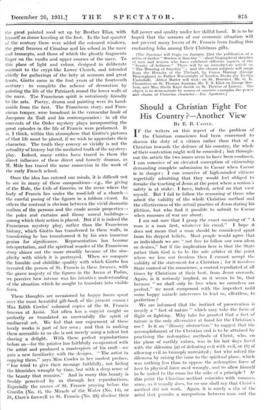Giotto and St. Francis*
BY EVELYN UNDERHILL.
THE disputes which long raged round the genius and the work of Giotto seem gradually to have died away, leaving him, after many vicissitudes, in possession of all the more famous paintings associated with his name. In the course of these controversies the great frescoes of Assisi suffered frequent changes of fortune and were attributed to many hands. But on the whole the series in the Upper Church, depicting the life of St. Francis, suffered least from the destructive methods of the critics, and is now generally admitted to be the authentic work of Giotto with his pupils and assistants.
The building of the Upper Church was finished about 1236. For years it remained with no decoration beyond • Giotto. The Legend of St. Francis, as depicted in the Assisi frescoes and faithfully copied by Edith M. Cowles. With a foreword by G. K. Chesterton. (Dent and Sons. 42s.) the great painted rood set ' up by Brother Elias, with himself as donor kneeling at the foot. In the last quarter of the century there were added the coloured windows, the great frescoes of Cimabue and his school in the nave and transepts, and those of which the ghostly fragments linger on the vaults and upper courses of the nave. To this place of light and colour, designed in deliberate contrast to the crypt-like Lower Church, and intended chiefly for gatherings of the laity at sermons and great feasts, Giotto came in the first years of the fourteenth century : to complete the scheme of decoration by painting the life of the Patriarch round the lower walls of the nave. The Franciscan spirit is notoriously friendly to the arts. Poetry, drama and painting were its hand- maids from the first. The Franciscan story, and Fran- ciscan temper, were broadcast in the vernacular laude of Jacopone da Todi and his contemporaries : in all the convents of the Order mystery plays incorporating the great episodes in the life of Francis were performed. It is, I think, within this atmosphere that Giotto's pictures of that life must be placed, if we wish to appreciate their character. The truth they convey so vividly is not the actuality of history but the mediated truth of the mystery- play. Indeed, many critics have traced in them the direct influence of these direct and homely dramas, as M. Male has traced the same connexion in the work of the early French school.
Once the idea has entered our minds, it is difficult not to see in many of these compositions—c.g., the giving of the Rule, the Crib of Greccio, or the scene where the body of Francis lies under the rood-loft of a church— the careful posing of the figures in a tableau vivant. In others the contrast is obvious between the vivid dramatic realism of the persons and the crude scenic properties— the poles and curtains and flimsy unreal buildings— among which their action is placed. But if it is indeed the Franciscan mystery play, rather than the Franciscan history, which Giotto has transferred to these walls, in transferring he has transformed it by his own immense genius for significance. Representation has become interpretation, and the spiritual wonder of the Franciscan story shines out the more steadily because of the sim- plicity with which it is portrayed. When we compare the humble and childlike quality with which Giotto has invested the person of St. Francis in these frescoes, with the grave majesty of the figures in the Arena at Padua, we perceive how intense was his intuitive understanding of the situation which he sought to translate into visible form.
These thoughts are occasioned by happy hours spent over the most beautiful gift-book of the present season : Miss Edith Cowles' coloured copies of the St. Francis frescoes at Assisi. Not often has a copyist caught so perfectly or translated so successfully the spirit of mediaeval art. We feel that our enjoyment of these lovely works is part of her own ; and that in making them accessible to us she is not merely using a talent but sharing a delight. With these perfect reproductions before us—for the printer has faithfully co-operated with the artist and produced a masterpiece of his craft—we gain a new familiarity with the designs. " The artist in copying them," says Miss Cowles in her modest preface, " has tried to give their message faithfully, not hiding the blemishes wrought by time, but with a deep sense of the beauty that remains." And in many this beauty is freshly perceived by us through her reproductions. Especially the scenes of .St. Francis praying before the Crucifix (No. 4), the Miracle of the Water (No. 14), or St, Clare's farewell to St. Francis (No. 23) disclose their full lower and quality under her skilful hand. It is to be hoped that the sorrows of our economic situation will not prevent many lovers of St. Francis from finding this enchanting folio among their Christmas gifts.
[The Spectator will begin on January 23rd the publication of a series of twelve " Studies in Sanctity "—short biographical sketches of men and women who have exhibited different aspects of the " beauty of holiness." There will be an introductory article on " The Meaning of Sanctity " ; and the chosen subjects will range from the Hermits of the Thobaid, by Canon Hannay (George Birmingham) to Father Wainwright of London Docks (by Evelyn Underhill). Abbot Butler will wilt on St. Benedict., Mr. G. K. Chesterton on St. Thomas Aquinas, Mr. T. S. Eliot on George Her- bert, and Miss Sheila Kaye Smith on St. Tlutr6se of Lisieux. The object is to demonstrate by means of concrete examples the power and charm of Christian character.—En. Spectator.]

































 Previous page
Previous page